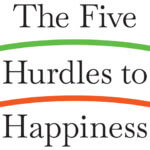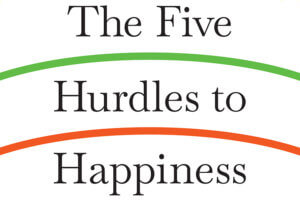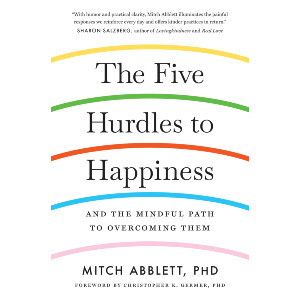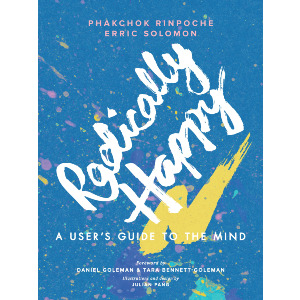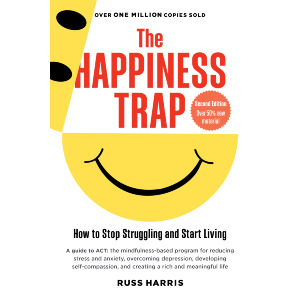An excerpt from The Five Hurdles to Happiness
I was once driving in semi-rural Ohio a few years back. After a state trooper’s flashing lights in my rear-view mirror snapped me out of my inner sagging, I pulled over to the side of the road.
The trooper eyed me from outside my driver’s window, clearly looking for signs I’d been drinking. “You were over the center line quite a bit back there,” he said. “Any alcohol for you today?”
I assumed I’d be doing some mindful walking on a line of the officer’s choosing outside my car, but after we talked for a minute or so, it was clear he was letting me go with a warning.
“Sorry to hear about your grandmother,” he said, nodding at me slightly before walking back toward his cruiser. I’d just told him that my grandmother had passed away several days prior and that I’d just left her funeral. Apparently, I’d become so absorbed in my emotional inner musing about things family—past and future—that my mind had sagged, and so did my hands at the wheel, leading to my sloppy (and dangerous) driving.
Mindfulness practice has a structural impact on the areas of the brain where our minds’ wilting meanderings arise.
Basically (to use a bit of psychobabble), I was ruminating that day in the car. By this I mean I was cycling through a series of negatively toned thoughts—repeating, analyzing, judging them—and increasingly not taking in the actual sensory realities of my body and my surroundings. Research has linked this sort of pejorative mind wandering to lower levels of happiness and higher reports of psychological disturbance.
Rumination is especially linked with anxiety and depressive disorders and with a network of structures in the brain, commonly referred to as the “default mode network” (DMN). These structures (such as the posterior cingulate cortex and the medial prefrontal cortex) appear to light up with activation when our inner experience is self-referentially focused. Basically, it’s when we’re lost in thought about ourselves. As the researcher Jud Brewer and his colleagues indicate, this happens about half of the time in our waking experience. Rumination is the negative, emotionally barbed variant of the wandering mind. Arguably, the DMN is active even as our minds are on the way toward serious sloth and torpor wilting—the wandering mind soon becomes the wilted mind.
What’s exciting from the standpoint of our work in this book is how meditation has been shown to bring about physical changes in the default mode network—mindfulness practice has a structural impact on the areas of the brain where our minds’ wilting meanderings arise. Brewer and his colleagues in the United States, as well as Joon Hwan Jang and his colleagues at Seoul National University, measured the degree of connectivity between areas of the DMN in thirty-five meditation practitioners versus thirty-three healthy control participants without any meditation experience. Using functional MRI scanning, these researchers found that meditation practitioners showed significantly greater linkage between these areas of the DMN in the medial prefrontal cortex of the brain. The DMN has been shown in previous studies to be most active when peoples’ attention is focused away from the external world and into inner experience (thoughts, emotions, and bodily sensations).
Basically, this study suggests that meditation experience is associated with an increased capacity for individuals to reduce mental activity (such as unhelpful mind—wandering/rumination) by accentuating their monitoring of internal bodily sensations and movement of energy throughout the body. Meditators appear to be more able to inhibit the process of rumination that leads to higher levels of stress, and this inhibition of excessive thinking may become more and more automatic (i.e., a new bio-conditioned pattern) with continued mindfulness practice.
I literally watched him fold himself over—wilt and go mute . . .
In addition to the wilting that comes from a mind that has become mired (and fatigued) by rumination, there is a wilting that occurs as a psychological self-protective mechanism against really intense experience. As Joseph Goldstein indicates, “there might be a strong and even traumatic emotion arising, and sometimes sloth and torpor arise as a defense against feeling it.”
As a therapist, I’ve worked with a number of clients who’ve experienced significant and terribly damaging trauma. From inpatient psychiatric patients to Vietnam combat veterans to adolescents in residential care, I’ve had frequent front-seat exposure to traumatic experience for those I’ve treated.
For one adolescent I worked with in a residential treatment program, I literally watched him fold himself over—wilt and go mute—in response to being asked to participate in a group therapy exposure session along with the other boys (all of whom had experienced significant trauma of one sort or another). This particular boy’s trauma was more intense than most (chronic sexual assault from his uncle with threats of being killed if he told anyone).
This boy, Billy, was known for his energy and wit. He was every teacher’s nightmare with his in-class callouts and spontaneous cutting up. His smile was impish and his mind always working on the next punch line. I loved that kid. He was the pick-me-up I often needed on my own wilting days at work—far more effective and worthwhile than my IV of coffee. Early on in my days as his therapy group leader, Billy even had the gall to smile at me and tell me that I had “a forehead big and flat enough to show a movie on.” It’s the rare kid who’s willing to call me out on my Frankenstein’s monster forehead (as my older brother had already done years before). I quietly respected him for it, even though I publicly sent him out of the group room for a time-out.
“It’s your turn, Billy,” I said. The boys were taking turns beginning to tell the story (what we in the field call a trauma narrative) of what happened to him over those days, weeks, and months in the attic of his mother’s home. “You can do it, dude. Don’t worry about getting anything wrong. You’re right here in the room with us. That was then and this is now.”
He mumbled a few words and proceeded to bend forward, placing his head on his knees. No matter what I or others said or did, he stayed that way for over fifteen minutes, completely unresponsive. Billy became a mannequin right in front of our eyes. He had truly and self-protectively wilted away. Less a pure falling asleep, it looked and felt more like a dissociative coma—a reflexive, brief emotional hibernation—he descended into.
Billy did not choose this reaction; it was his mind’s learned pattern for staving off further pain, and it arose reflexively when the environment tripped the wires of traumatic memory.
We need a balance of concentration of mind on the situation at hand with the energy flow in our bodies.
We do not choose our karmic conditioning—it shows up in us moment to moment. Our choice is only in whether we see our patterns with the bright light of awareness. Patterning has a way of burning itself out if left alone in the spotlight of open knowing. There appears to be a causal flow of input and output in our bodies and minds. What comes into us by way of contact with the world, if not met with awareness, leads in lockstep to what comes out of us by way of reactive thinking, emotions, and behavior.
We need a balance of concentration of mind on the situation at hand with the energy flow in our bodies. Without this balance, we can (in the case of insufficient energy in the body, excessive rumination like my day in the car in Ohio, or a self-protective drawdown of energy in the case of trauma reactions like Billy’s) slide away into hindering patterns of wilting.
As the parable goes, the Buddha was talking with one of his disciples who believed himself to be the most energetic in his practice of meditation, more so than all the others.
“And yet you have not found freedom, correct?” asked the Buddha.
“Yes, my lord,” said his disciple.
“Tell me,” said the Buddha. “Were you not once quite skilled at playing string music on the lute?”
“Yes, my lord.”
“And tell me—when the strings of the lute were too tight, was the lute playable?”
“No, my lord.”
“And when they were too loose?”
“Certainly not, my lord.”
“And yet when the strings were adjusted to be not too loose and not too tight, you could play at perfect pitch, correct?”
“Yes, that’s right, my lord.”
“So it is with you,” said the Buddha. “If the energy is applied too much, it leads to restlessness, and if not enough, it leads to lethargy. Therefore, you must keep your energy in balance, and you will make progress on the path toward freedom.”
The meditation teacher and monastic Ajahn Thiradhammo says that managing our wilting minds requires a “careful balance of ‘just enough’”—we need just the right mixture of concentration and amount of energy in our moments of practice, and then meditation will progress, and we will not be sidelined by this wilting pattern. If we’re willing and skillful at turning what energy of attention we have toward investigating what’s showing up in our experience (thoughts and bodily sensations), then we might stumble upon insight into what’s causing our dullness in the first place. . . .
Opening by Exploring the Pain and Potential of Wilting
Buddhism would characterize sloth and torpor as “basically a lack of energy, and the fundamental dynamic is first deflation, followed by collapse.” The practitioner would ideally learn to recognize it before it becomes excessive or habitual, determine its cause, see clearly what factors seem to alleviate or prevent it, and then set about leveraging this hard-won information to create as stable and steady an energy foundation in the body-mind as possible. This foundation would allow the practitioner to climb higher into jhanic realms of concentration and ultimately enlightenment itself.
Curiosity is the key. Whether we’re currently wilting or not, it can help us get better at delving into a deeper understanding of this hindrance pattern . . .
Coming out of the idealistic dharmic clouds and into the lowly hotel conference room, I have many times noticed what appears to be boredom overtaking the faces of attendees at workshops and seminars I’ve led. While I used to find myself deflated by this “clear” vote of no confidence in my abilities as a speaker, I now (usually) see the glazed-over look in folks’ eyes as the result of that impossibly complex admixture of psychophysiological factors that we lump together with the term “boredom.”
As Gil Fronsdal writes, though, “nothing is inherently boring; boredom is a judgment, an activity of the mind.” We need to do better than a simple, dismissive “I’m just bored.” Our society regards boredom as a justifiable, external fact of certain situations. We blame our office cubicles, living rooms, and dinner dates for boring us and forsake any inner responsibility for the patterning within that is allowing for this maligned state of wilting to emerge in the first place. Instead of looking out at the world with a deflated, passive frown when bored, we could instead take such an experience as a call to curiosity. We could perk up just enough to begin asking what is happening inside and around us to create this experience. We could wonder what we might be wanting at that moment and thereby trip across another hindrance (like desire/wanting or hostility/wrestling), which may be draining our energy.
Curiosity is the key. Whether we’re currently wilting or not, it can help us get better at delving into a deeper understanding of this hindrance pattern (and all of them) by building a habit of curious engagement with ourselves and the environment. Bill Morgan writes in his book The Meditator’s Dilemma how meditators in the West are often blocked in their practices by a dry, stiff, and achievement- and outcome-oriented approach to meditation. Borrowing from the developmental psychologist and theoretician D. W. Winnicott, Morgan discusses the benefits of consciously creating a wholesome, enlivening “holding environment” for one’s meditation practice.
According to Morgan, our meditation can bloom if we are simply (yet elusively) willing to relax and invigorate our bodies and open our minds with gratitude and emotional warmth. Like a child’s need for a consistent, supportive, welcoming, relaxed emotional climate from his or her caregivers, so do meditators need a holding environment with such qualities in order to flourish in their practice of meditation. And I believe we can take this further. We benefit from leaping toward our daily experience (whether in formal sitting meditation or while sitting waiting for an Uber) from a platform that truly supports and enlivens us.
Share
Related Books
$17.95 - Paperback
$19.95 - Paperback
The Happiness Trap (Second Edition)
$19.95 - Paperback


